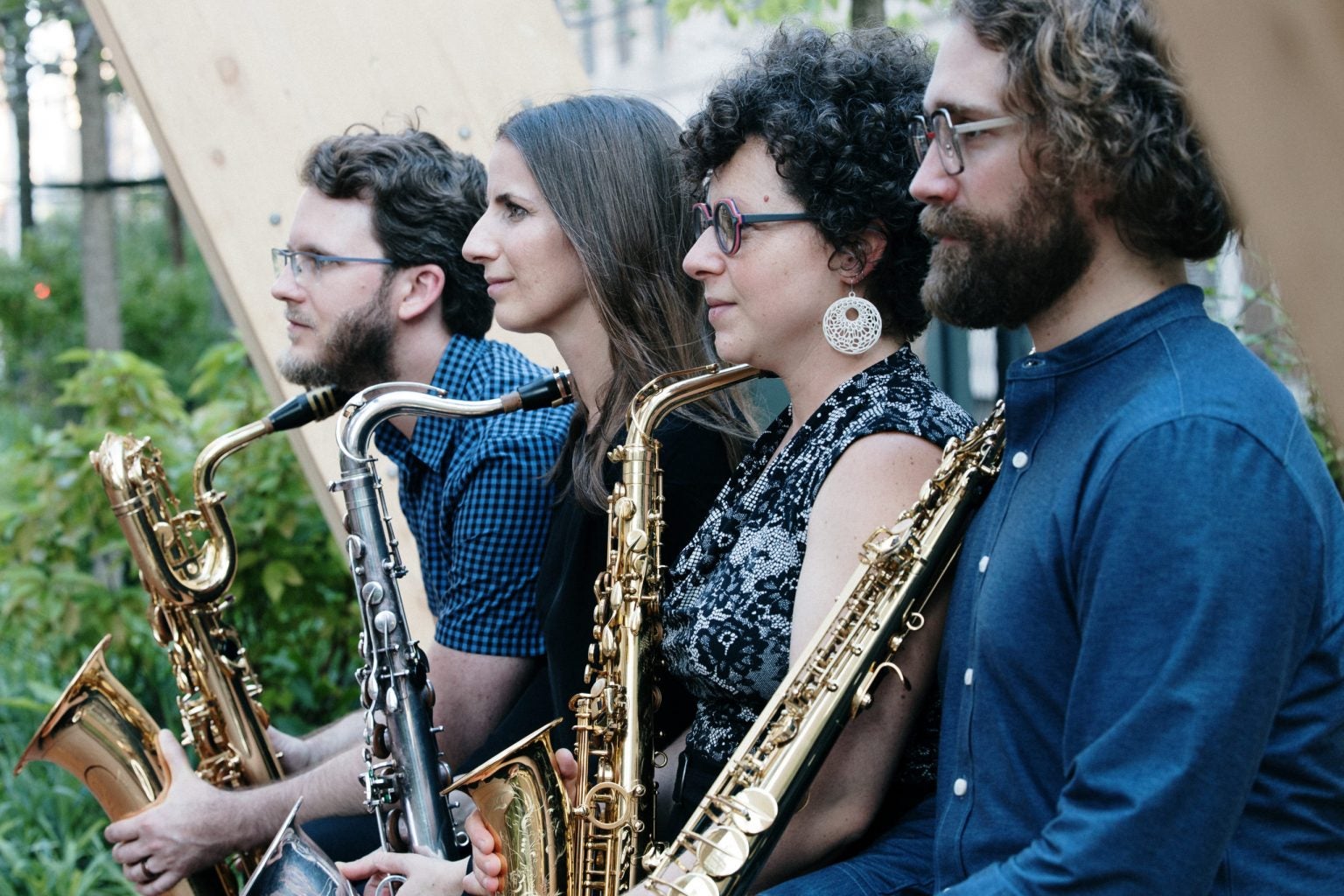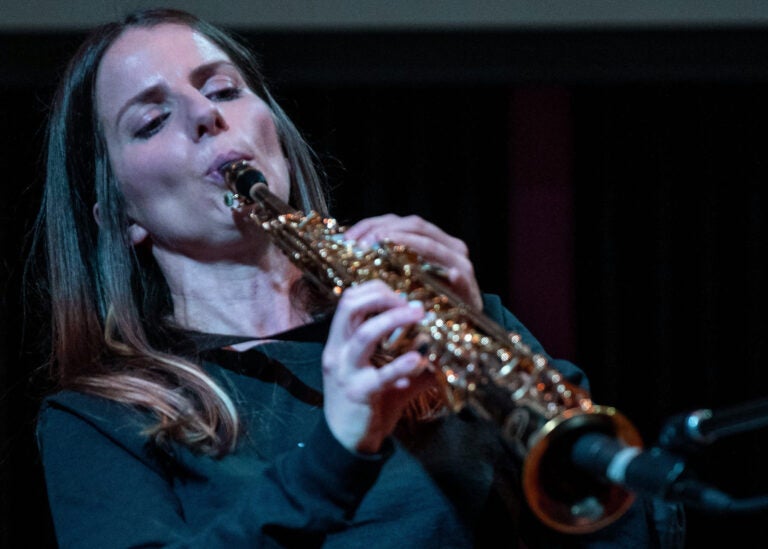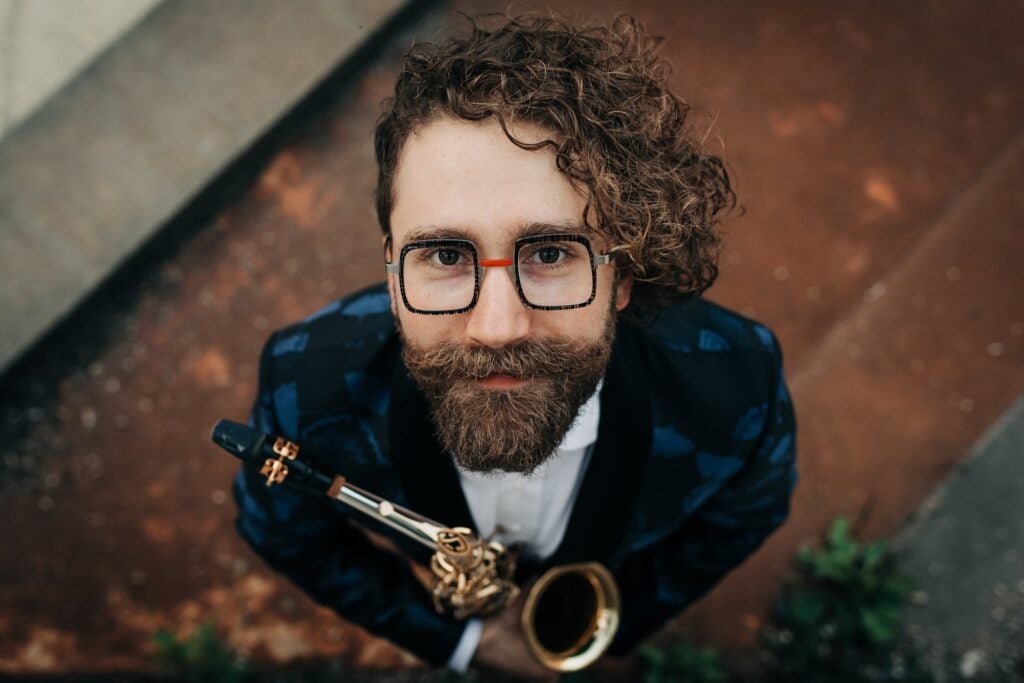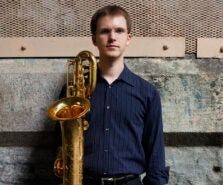
New Thread Quartet: Works by UCLA Faculty and Student Composers
Co-presented by the UCLA Music Library, Davise Fund and the R.U. Nelson Fund
New Thread Quartet
Jonathan Hulting-Cohen – Soprano Saxophone
Kendra Wheeler – Alto Saxophone
Erin Rogers – Tenor Saxophone
Zach Herchen – Baritone Saxophone
Tuesday January 30, 2024
Evelyn and Mo Ostin Music Center: Ensemble Room
8:00pm
Performers

Erin Rogers
See Bio
Saxophonist/Composer Erin Rogers is founder and Co-Artistic director of NYC-based ensembles: thingNY, Popebama, New Thread Quartet, Hypercube and a core member of LA-based WildUp. Her music has been performed worldwide at the Celebrity Series (Boston), David Geffen Hall (Lincoln Center), Hamburg Elbphilharmonie, Prototype, Ecstatic, and MATA Festivals, Edmonton Symphony Orchestra, Centro Nacional de las Artes (Mexico City), Carnegie Hall, and NYmusikk Bergen (Norway). Rogers is a D’Addario Woodwinds and Conn-Selmer artist, a Chamber Music Society of Lincoln Center teaching artist, and Co-Chair of the Manhattan School of Music Contemporary Performance Program. Rogers has recorded two solo albums for Relative Pitch Records.
erinmrogers.com

Jonathan Hulting-Cohen
See Bio
Saxophonist Jonathan Hulting-Cohen made their concerto debut with the Philadelphia Classical Symphony in 2011. As recitalist and chamber musician, Jonathan has performed at Chamber Music Northwest, Carnegie Hall, Virtuosi Concert Series in Winnipeg and the Edinburgh FringeFestival. Jonathan is Associate Professor of Saxophone at the University of Massachusetts Amherst, plays in The Moanin’ Frogs and Admiral Launch Duo, and endorses Conn-Selmer, D’Addario Woodwinds, Key Leaves and Silverstein products.
jonathanhultingcohen.com

Zach Herchen
See Bio
Saxophonist Zach Herchen performs contemporary, jazz, and rock music. He has premiered dozens of pieces ranging from Japanese noise rock to jazz tone poems to multimedia works. He performs with First Construction, Emerging Voices Project, Rhymes With Opera, Quiet City, and Man Down. Zach has served on staff at NEC’s Summer Institute for Contemporary Performance Practice and was an artist-in-resident at Wildacres Retreat. He has performed at BU’s Spectral Summer Professional Performance Workshop, the SEAMUS National Conference, Third Practice Electroacoustic Festival, the 4th International Master-Class for Classical Saxophone, and the Look & Listen Festival. Zach has performed as a soloist in Italy, Sweden, Germany, and at various American institutions. Zach holds a MM and BM in Saxophone Performance (and BM in Recording Arts Engineering) from The Peabody Conservatory.
www.zachherchen.com
Repertoire
Sydney Wang
Little Thrift Shop (2024)
Kay Rhie
Night Blooms (2019, rev. 2023)
Peter Golub
Florestan and Eusebius (2015, revised 2024)
Austin Ali
Four Chorales - Nos. 1 and 2 (2024)
Charles Burns
The Resonant Veil
David S. Lefkowitz
Spiral Galaxy (2011)
Noah Meites
Fracture Mechanics (2022)
John Hollywood
Afterwards (2024)
Morgan Moss
Rabbit (2024)
Program Notes
Austin Ali, Four Chorales - Nos. 1 and 2 (2024)
Four Chorales represent four snapshots from my composing journey in LA, one from each year I have lived here. Totaling now fifty entries, my Chorale Journal serves as a place for both musical experimentation and inspiration. I can think of no better ensemble than the New Thread Quartet to bring these chorales to a live audience for the first time.
“2021” dates to October 1 st , 2021, the first chorale I wrote after starting in-person classes at UCLA. You can hear my genuine love for music and the pure joy of finally making music together in-person.
“2022” traces to September 2 nd , 2022, far after I had settled into LA and became comfortable enough to experiment. You’ll hear some hints of bitonality and experiments in timbre, inspired by collaborating with the New Thread performers.
As for “2023” and “2024,” I will post them on my website! (austinali.com)
A special thank-you to Dr. Noah Meites, the UCLA composition division, and the New Thread Quartet for their efforts in making this residency possible.
Charles Burns, The Resonant Veil (2024)
something something Palestrina something
Peter Golub, Florestan and Eusebius (2015, revised 2024)
About 10 years ago I was on a flight to Bratislava to record a film score. I had scheduled 14 hours to record about an hour of music and I thought it very possible that I'd have an hour or so of extra studio time. Wanting to take advantage of the large orchestra, on the plane I wrote several short studies. One of these studies I adapted for the first section of this saxophone quartet which I wrote in 2015 for a commission from Skidmore College. And with the exciting prospect of a performance by New Thread, I rewrote the ending, which never felt right. The first section is very circus-y, which is something I generally like to do with winds and brass. After that the piece alternates between extroverted and introverted, ecstatic and calm, brash and dolce. Hence the title, which refers to Robert Schumann's alter egos.
John Hollywood, Afterwards (2024)
This piece is about trying to hold onto a good memory by fixing it in one's mind. Of course this can't be done, and distortions are inevitable. I'd like the overall tone to be earnest and warm.
David S. Lefkowitz, Spiral Galaxy (2011)
Spiral Galaxy is a seven-minute piece exploring the ideas of melodic intrusion and rotational symmetry. The first movement, Galactic Intrusion, is entirely diatonic: it is not the harmony, but the melodic movement of one line into — and emerging out the other side of — the midst of a swirling tremolo.
The second movement, Spiral Galaxy, also juxtaposes strongly- directional lines against a simple harmonic background. In this movement, the harmonic background (played with slap-tongue articulations) is far more active, while the lines move precipitously toward or away from that harmonic core.
Both movements are constructed so that each gesture or passage in the piece is subsequently repeated upside-down and backwards — hence the “rotational symmetry.” This symmetry, and the way the lines spin into and away from the center, are reminiscent of images of spiral galaxies, seen from the Hubble Telescope (and as shown on the cover of this music).
Spiral Galaxy was written for the Angeles Saxophone Quartet (Christopher Elchico, soprano, Ryan Weston, alto, Umut Dursun, tenor, and Andrew Barnhart, baritone saxophones), and was premiered by them on the 1st of March, 2011.
Noah Meites, Fracture Mechanics (2022)
Flaws in the material produce
stress concentrators that cause premature failure
Sharp corners produce
large stress concentrations
Intergranular, Transgranular, Elastic Strain Energy
Stress intensity is a function of loading,
crack size, and structural geometry
Cracks grow faster as amplitude increases
Morgan Moss, Rabbit (2024)
Originally a work for solo piano, Rabbit has been adapted for the New Thread Quartet. The sweet and playful nature of the music is enhanced by the flexible expressivity of this new instrumentation, and New Thread's virtuosity both as soloists and as an ensemble bring the work bounding to life! While the music was originally written as an assignment on broadening our musical horizons, it has gained new life as a concert work. This piece is dedicated to Dr. Kay Rhie, also featured on the program tonight: Thank you always for your wisdom, guidance, and open-mindedness; this piece would not exist if it weren't for you!
Thank you also to the New Thread Quartet and Dr. Noah Meites for making this concert possible... We all so appreciate you sharing your knowledge, talent, and contributing to new music by commissioning new works for saxophone quartet (and being kind enough to play them)!
Kay Rhie, Night Blooms (2019, rev. 2023)
Night Blooms was written shortly after the passing of my father in 2019 and recently revised for New Thread Quartet. My father was a writer, most active during the 1960-80’s in South Korea until the family immigrated to the States. Since the move, he had taken odd jobs until he started working for a local Korean newspaper in Los Angeles. He never returned to creative writing since the immigration. I don’t think I ever asked why.
Spending many late hours at the hospital where he spent his last days, mostly reliant on the breathing machine which consistently expanded and shrank, I was reminded of the flowers that bloom only during the night. This was especially after I found among his medical papers a large collection of articles and scribbles – all of which were obviously possible source materials for his to-be-written stories. I sensed bursts of desires there that I did not know about. Like the night flowers that bloom when people are asleep, my father and many first-generation immigrants probably dreamed of beautiful “blooms” during the quiet hours when not too many took notice.
In the beginning of the piece, fragmented gestures are driven with energy but often interrupted by silence, until finally a continuous gesture blossoms into a sweeping motion. Then the piece evolves into longer melodic materials, or an elegiac dance, ending with a rather peaceful celebration of quietude.
-Kay Kyurim Rhie
Sydney Wang, Little Thrift Shop (2024)
In the town where I grew up, there was a little thrift shop a few minutes from my house that my mom and I would visit now and then – sometimes in search of a specific item, but most times to simply enjoy the cozy atmosphere of the shop and its friendly employees. I loved that each item in the shop – be it a worn old book, a faded silk dress, a vintage clock, or a stuffed teddy bear – held a story within it, a vignette of a time in its owner's life. And as a lover of stories, I enjoyed imagining what role – big or small – each item once played. To me, a thrift shop is a joyful and whimsical example of what it means to find wonder in the little things in life, and I sought to capture that essence in Little Thrift Shop.